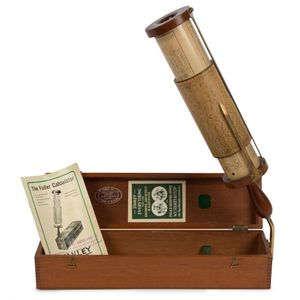1920s Fuller's Spiral Cylindrical Slide Rule Calculator with Case
A Fuller's Spiral Cylindrical Slide Rule Calculator Stanley & Co., London, circa 1920s. A 17 inch (44.5 cm) long hand-held cylindrical slide rule calculator, No 7906, with sliding drum scales, lacquered brass reading bar, mahogany caps and handle. Housed in the original fitted case with brass holding bracket, lid of case with paper manufacturer's label. With Instructions for the Use of the calculator. Patented in 1878, the Fuller Calculator was the most advanced calculating tool of its time, with its innovative cylindrical design allowing it the same calculating power as a more than 80 foot long straight slide rule.
You must be a subscriber, and be logged in to view price and dealer details.
Subscribe Now to view actual auction price for this item
When you subscribe, you have the option of setting the currency in which to display prices to $Au, $US, $NZ or Stg.
This item has been sold, and the description, image and price are for reference purposes only.
- Mahogany - Mahogany is a dense, close grained red-coloured timber from the West Indies and Central America. It was first imported into Europe in the the early 18th century and its use continued through the 19th century. It was popular for furniture making because of its strength, the wide boards available, the distinctive grain on some boards, termed flame mahogany and the rich warm colour of the timber when it was polished.. The "flame" was produced where a limb grew out from the trunk of the tree, and this timber was usually sliced into veneers for feature panels on doors, backs and cornices.
Some terms used to describe mahogany relate to the country from which it originally came, such as "Cuban" mahogany, "Honduras" mahogany etc. However unless the wood has been tested the names assigned are more a selling feature, rather than a true indication of the timber's origin. - Circa - A Latin term meaning 'about', often used in the antique trade to give an approximate date for the piece, usually considered to be five years on either side of the circa year. Thus, circa 1900 means the piece was made about 1900, probably between 1895 and 1905. The expression is sometimes abbreviated to c.1900.
This item has been included into following indexes:
